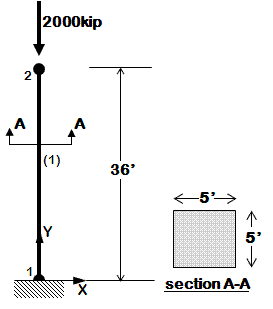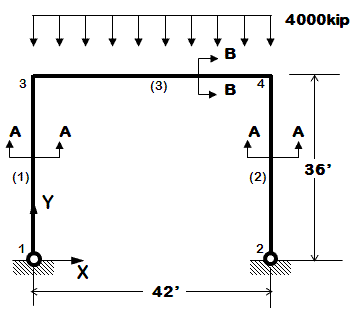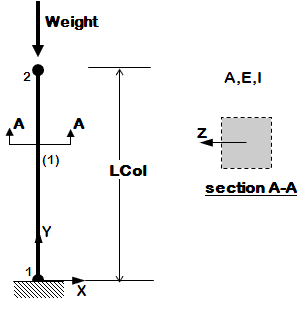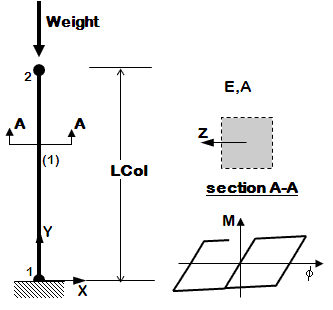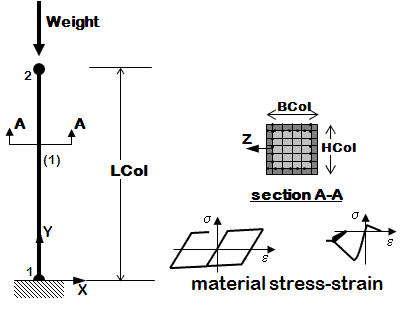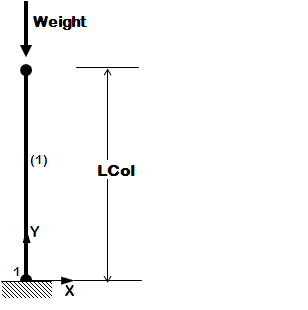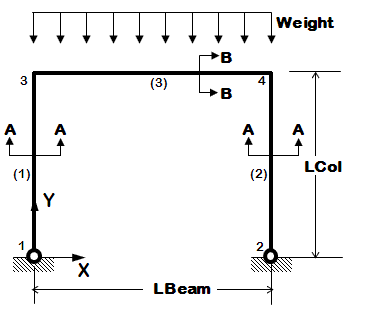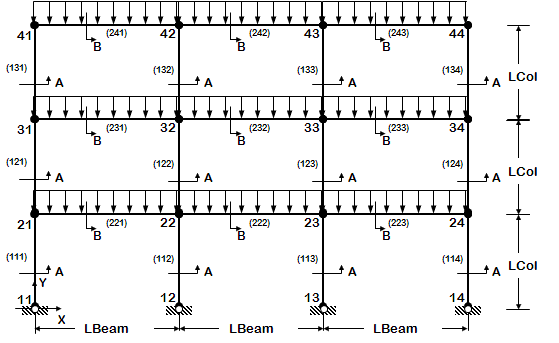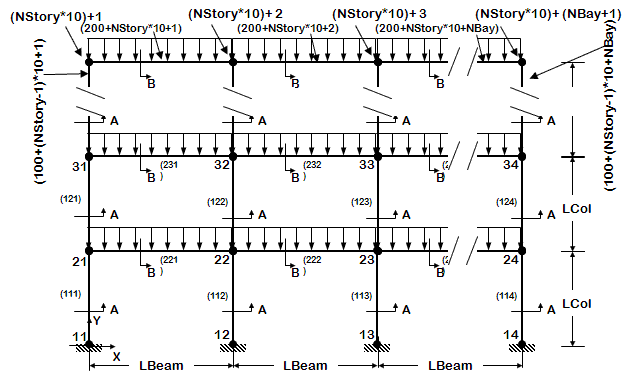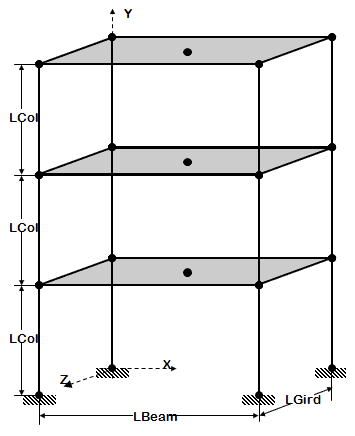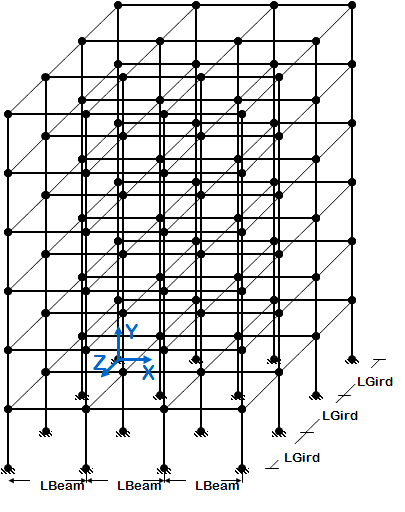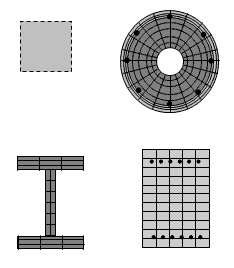OpenSees Examples Manual -- Structural Models & Anlyses: Difference between revisions
No edit summary |
m (moved OpenSees Examples Manual -- Structural Models & Analyses to OpenSees Examples Manual -- Structural Models & Anlyses: revert) |
||
| (83 intermediate revisions by one other user not shown) | |||
| Line 1: | Line 1: | ||
<!-- INTRODUCTION --> | <!-- INTRODUCTION --> | ||
<h1>Introduction</h1> | |||
The examples in this manual are listed in order of simplicity. | |||
NOTE: gravity analysis is always included as part of the model building | NOTE: gravity analysis is always included as part of the model building | ||
<!-- MODELS --> | |||
<h1>Models</h1> | |||
The following types of models are represented in these examples: | |||
A | :;<h2>Elastic Elements</h2> | ||
: OpenSees [[Elastic Beam Column Element]] | |||
: The elastic, uncoupled, axial and flexural stiffnesses are defined at the element level | |||
: user specifies: E,I,A | |||
:;<h2>Inelastic Elements</h2> | |||
: OpenSees [[Force-Based Beam-Column Element]] | |||
: Two types of sections | |||
::<h3>Uniaxial Section</h3> | |||
::: The inelastic, uncoupled, axial and flexural stiffnesses are defined at the section level | |||
::: The OpenSees [[Uniaxial Section]] Command is used | |||
::: User specifies: | |||
:::: Axial stiffness A | |||
:::: Section Moment-Curvature characteristics via the OpenSees [[UniaxialMaterial Command]] | |||
::<h3>Fiber Section</h3> | |||
::: The section is broken down into fibers where uniaxial materials are defined independently. | |||
::: The program calculates the coupled flexural and axial stiffnesses/strength by integrating strains across the section | |||
::: The OpenSees [[Fiber Section]] Command is used | |||
::: User specifies | |||
:::: Stress-Strain characteristics via the OpenSees [[UniaxialMaterial Command]] for all number of materials | |||
:::: Section geometry via series of Patches and Layers in the fiber section | |||
::: Two Section Geometries are presented | |||
:::: *RC Rectangular Section | |||
:::: *Standard AISC W section | |||
<!-- LATERAL LOADS --> | |||
<h1>Lateral Loads</h1> | |||
The following types of lateral loads are represented in these examples: | |||
[[File:StaticPushoverLoads_Figure1.GIF|link=OpenSees Examples Manual -- Structural Models & Analyses|right]] | |||
:;<h2> Static Pushover</h2> | |||
: Control node is located at the highest floor | |||
: Lateral-load distribution is proportional the the mass distribution along the height of the building | |||
: Static analysis | |||
: Two types | |||
::<h3>Monotonic Pushover</h3> | |||
::: One-directional displacement-controlled static lateral loading | |||
::<h3>Reversed Cyclic Pushover</h3> | |||
::: One-directional displacement-controlled static lateral loading | |||
::: Displacement cycles are imposed in positive and negative direction | |||
[[File:TimeDependent_Figure1.GIF|link=OpenSees Examples Manual -- Structural Models & Analyses|right]] | |||
:;<h2> Time-Dependent Dynamic Loads</h2> | |||
: Transient analysis | |||
: Four types | |||
::<h3>Uniform Sine-Wave</h3> | |||
::: Sine-wave acceleration input | |||
::: Same acceleration input at all nodes restrained in specified direction | |||
::<h3>Multiple-Support Sine-Wave</h3> | |||
::: Sine-wave displacement input | |||
::: Different displacements are specified at particular nodes in specified directions | |||
::<h3>Uniform Earthquake</h3> | |||
::: Earthquake (from file) acceleration input | |||
::: Same acceleration input at all nodes restrained in specified direction | |||
::<h3>Multiple-Support Earthquake</h3> | |||
::: Earthquake (from file) displacement input | |||
::: Different displacements are specified at particular nodes in specified direction | |||
::<h3>Bidirectional Earthquake</h3> | |||
::: Different inputs are specified for two directions | |||
::: Same acceleration input at all nodes restrained in specified direction | |||
<!-- SIMULATION --> | |||
<h1>Simulation Process</h1> | |||
#nodal | Each example script does the following:<br> | ||
# | :<h2>Build the model</h2> | ||
# | :#model dimensions and degrees-of-freedom | ||
# | :#nodal coordinates | ||
# | :#nodal constraints -- boundary conditions | ||
:#nodal masses | |||
:#elements and element connectivity | |||
:#recorders for output | |||
:<h2>Define & apply gravity load</h2> | |||
:#nodal or element load | |||
:#static-analysis parameters (tolerances & load increments) | |||
:#analyze | |||
:#hold gravity loads constant | |||
:#reset time to zero | |||
:<h2> Define and apply lateral load </h2> | |||
#load pattern (nodal loads for static analysis, support ground motion for earthquake) | :#load pattern (nodal loads for static analysis, support ground motion for earthquake) | ||
#lateral-analysis parameters (tolerances & displacement/time increments) | :#lateral-analysis parameters (tolerances & displacement/time increments) | ||
#damping | :#*Static Lateral-Load Analysis | ||
#analyze | :#**define the displacement increments and displacement path | ||
:#*Dynamic Lateral-Load Analysis | |||
:#**define the input motion and all associated parameters, such as scaling and input type | |||
:#**define analysis duration and time increment | |||
:#**define damping | |||
:#analyze | |||
<h1>Introductory Examples</h1> | |||
The objective of Example 1a and Example 1b is to give an overview of input-file format in OpenSees using simple scripts. <br> | |||
</ | These scripts do not take advantage of the Tcl scripting capabilities shown in the later examples. However, they do provide starting a place where the input file is similar to that of more familiar Finite-Element Analysis software. Subsequent examples should be used as the basis for user input files. | ||
<!-- SECTION --> | <!-- SECTION --> | ||
:<h2>[[OpenSees Example 1a. 2D Elastic Cantilever Column ]]</h2> | |||
<!-- subSECTION 1 --> | <!-- subSECTION 1 --> | ||
<!-- 4 COLUMNS --> | <!-- 4 COLUMNS --> | ||
{| style="margin:0; background:none;" | {| style="margin:0; background:none;" | ||
<!-- Column 1 image --> | <!-- Column 1 image --> | ||
| style="margin:0; style="width:25%; border:1px solid # | |- | ||
| style="margin:0; style="width:25%; border:1px solid #red; background:#white; vertical-align:top;"| | |||
{| style="width:100%; vertical-align:top; background:#white;" | {| style="width:100%; vertical-align:top; background:#white;" | ||
! style="padding:2px" | | ! style="padding:2px" | | ||
| Line 79: | Line 118: | ||
|} | |} | ||
<!-- Column 2 --> | <!-- Column 2 --> | ||
| style="margin:0; width:25%; border:1px solid # | | style="margin:0; width:25%; border:1px solid #red; background:#white; vertical-align:top; " | | ||
{| style="width:100%; vertical-align:top; background:#white;" | {| style="width:100%; vertical-align:top;background:#white;" | ||
! style="padding:2px" | <strong>Objectives</strong> | ! style="padding:2px" | <strong>Objectives</strong> | ||
|- | |- | ||
| Line 90: | Line 129: | ||
|} | |} | ||
<!-- Column 3 --> | <!-- Column 3 --> | ||
| style="margin:0; width:25%; border:1px solid # | | style="margin:0; width:25%; border:1px solid #red; background:#white; vertical-align:top; " | | ||
{| style="width:100%; vertical-align:top; background:#white;" | {| style="width:100%; vertical-align:top; background:#white;" | ||
! style="padding:2px" | <strong>Models</strong> | ! style="padding:2px" | <strong>Models</strong> | ||
| Line 99: | Line 138: | ||
|} | |} | ||
<!-- Column 4 --> | <!-- Column 4 --> | ||
| style="margin:0; width:25%; border:1px solid # | | style="margin:0; width:25%; border:1px solid #red; background:#white; vertical-align:top; " | | ||
{| style="width:100%; vertical-align:top; background:#white;" | {| style="width:100%; vertical-align:top; background:#white;" | ||
! style="padding:2px" | <strong>Analyses</strong> | ! style="padding:2px" | <strong>Analyses</strong> | ||
| Line 110: | Line 149: | ||
|} | |} | ||
<!-- SECTION --> | <!-- SECTION --> | ||
:<h2>[[OpenSees Example 1b. Elastic Portal Frame]]</h2> | |||
<!-- subSECTION 2 --> | |||
< | |||
< | |||
<!-- 4 COLUMNS --> | <!-- 4 COLUMNS --> | ||
{| style="margin:0; background:none;" | {| style="margin:0; background:none;" | ||
<!-- Column 1 image --> | <!-- Column 1 image --> | ||
| style="margin:0; style="width:25%; border:1px solid # | | style="margin:0; style="width:25%; border:1px solid #red; background:#white; vertical-align:top;" | | ||
{| style="width:100%; vertical-align:top; background:#white;" | {| style="width:100%; vertical-align:top; background:#white;" | ||
! style="padding:2px" | | ! style="padding:2px" | | ||
| Line 130: | Line 163: | ||
<!-- Column 2 --> | <!-- Column 2 --> | ||
| style="margin:0; width:25%; border:1px solid # | | style="margin:0; width:25%; border:1px solid #red; background:#white; vertical-align:top; " | | ||
{| style="width:100%; vertical-align:top; background:#white;" | {| style="width:100%; vertical-align:top; background:#white;" | ||
! style="padding:2px" | <strong>Objectives</strong> | ! style="padding:2px" | <strong>Objectives</strong> | ||
| Line 140: | Line 173: | ||
|} | |} | ||
<!-- Column 3 --> | <!-- Column 3 --> | ||
| style="margin:0; width:25%; border:1px solid # | | style="margin:0; width:25%; border:1px solid #red; background:#white; vertical-align:top; " | | ||
{| style="width:100%; vertical-align:top; background:#white;" | {| style="width:100%; vertical-align:top; background:#white;" | ||
! style="padding:2px" | <strong>Models</strong> | ! style="padding:2px" | <strong>Models</strong> | ||
| Line 149: | Line 182: | ||
|} | |} | ||
<!-- Column 4 --> | <!-- Column 4 --> | ||
| style="margin:0; width:25%; border:1px solid # | | style="margin:0; width:25%; border:1px solid #red; background:#white; vertical-align:top; " | | ||
{| style="width:100%; vertical-align:top; background:#white;" | {| style="width:100%; vertical-align:top; background:#white;" | ||
! style="padding:2px" | <strong>Analyses</strong> | ! style="padding:2px" | <strong>Analyses</strong> | ||
| Line 163: | Line 196: | ||
<h1>Simple Examples of Nonlinear-Models</h1> | |||
<!-- SECTION --> | <!-- SECTION --> | ||
:<h2>[[OpenSees Example 2a. Elastic Cantilever Column with variables]]</h2> | |||
<!-- subSECTION 1 --> | <!-- subSECTION 1 --> | ||
<!-- 4 COLUMNS --> | <!-- 4 COLUMNS --> | ||
{| style="margin:0; background:none;" | {| style="margin:0; background:none;" | ||
<!-- Column 1 image --> | <!-- Column 1 image --> | ||
| style="margin:0; style="width:25%; border:1px solid # | | style="margin:0; style="width:25%; border:1px solid #red; background:#white; vertical-align:top;" | | ||
{| style="width:100%; vertical-align:top; background:#white;" | {| style="width:100%; vertical-align:top; background:#white;" | ||
! style="padding:2px" | | ! style="padding:2px" | | ||
| Line 186: | Line 212: | ||
|} | |} | ||
<!-- Column 2 --> | <!-- Column 2 --> | ||
| style="margin:0; width:25%; border:1px solid # | | style="margin:0; width:25%; border:1px solid #red; background:#white; vertical-align:top; " | | ||
{| style="width:100%; vertical-align:top; background:#white;" | {| style="width:100%; vertical-align:top; background:#white;" | ||
! style="padding:2px" | <strong>Objectives</strong> | ! style="padding:2px" | <strong>Objectives</strong> | ||
| Line 195: | Line 221: | ||
|} | |} | ||
<!-- Column 3 --> | <!-- Column 3 --> | ||
| style="margin:0; width:25%; border:1px solid # | | style="margin:0; width:25%; border:1px solid #red; background:#white; vertical-align:top; " | | ||
{| style="width:100%; vertical-align:top; background:#white;" | {| style="width:100%; vertical-align:top; background:#white;" | ||
! style="padding:2px" | <strong>Models</strong> | ! style="padding:2px" | <strong>Models</strong> | ||
| Line 204: | Line 230: | ||
|} | |} | ||
<!-- Column 4 --> | <!-- Column 4 --> | ||
| style="margin:0; width:25%; border:1px solid # | | style="margin:0; width:25%; border:1px solid #red; background:#white; vertical-align:top; " | | ||
{| style="width:100%; vertical-align:top; background:#white;" | {| style="width:100%; vertical-align:top; background:#white;" | ||
! style="padding:2px" | <strong>Analyses</strong> | ! style="padding:2px" | <strong>Analyses</strong> | ||
| Line 215: | Line 241: | ||
|} | |} | ||
<!-- SECTION --> | <!-- SECTION --> | ||
:<h2>[[OpenSees Example 2b. Nonlinear Cantilever Column: Uniaxial Inelastic Section]]</h2> | |||
<!-- subSECTION 2 --> | <!-- subSECTION 2 --> | ||
<!-- 4 COLUMNS --> | <!-- 4 COLUMNS --> | ||
{| style="margin:0; background:none;" | {| style="margin:0; background:none;" | ||
<!-- Column 1 image --> | <!-- Column 1 image --> | ||
| style="margin:0; style="width:25%; border:1px solid # | | style="margin:0; style="width:25%; border:1px solid #red; background:#white; vertical-align:top;" | | ||
{| style="width:100%; vertical-align:top; background:#white;" | {| style="width:100%; vertical-align:top; background:#white;" | ||
! style="padding:2px" | | ! style="padding:2px" | | ||
| Line 235: | Line 255: | ||
|} | |} | ||
<!-- Column 2 --> | <!-- Column 2 --> | ||
| style="margin:0; width:25%; border:1px solid # | | style="margin:0; width:25%; border:1px solid #red; background:#white; vertical-align:top; " | | ||
{| style="width:100%; vertical-align:top; background:#white;" | {| style="width:100%; vertical-align:top; background:#white;" | ||
! style="padding:2px" | <strong>Objectives</strong> | ! style="padding:2px" | <strong>Objectives</strong> | ||
| Line 244: | Line 264: | ||
|} | |} | ||
<!-- Column 3 --> | <!-- Column 3 --> | ||
| style="margin:0; width:25%; border:1px solid # | | style="margin:0; width:25%; border:1px solid #red; background:#white; vertical-align:top; " | | ||
{| style="width:100%; vertical-align:top; background:#white;" | {| style="width:100%; vertical-align:top; background:#white;" | ||
! style="padding:2px" | <strong>Models</strong> | ! style="padding:2px" | <strong>Models</strong> | ||
| Line 254: | Line 274: | ||
|} | |} | ||
<!-- Column 4 --> | <!-- Column 4 --> | ||
| style="margin:0; width:25%; border:1px solid # | | style="margin:0; width:25%; border:1px solid #red; background:#white; vertical-align:top; " | | ||
{| style="width:100%; vertical-align:top; background:#white;" | {| style="width:100%; vertical-align:top; background:#white;" | ||
! style="padding:2px" | <strong>Analyses</strong> | ! style="padding:2px" | <strong>Analyses</strong> | ||
| Line 265: | Line 285: | ||
|} | |} | ||
<!-- SECTION --> | <!-- SECTION --> | ||
:<h2>[[OpenSees Example 2c. Nonlinear Cantilever Column: Inelastic Uniaxial Materials in Fiber Section ]]</h2> | |||
<!-- subSECTION 3 --> | <!-- subSECTION 3 --> | ||
<!-- 4 COLUMNS --> | <!-- 4 COLUMNS --> | ||
{| style="margin:0; background:none;" | {| style="margin:0; background:none;" | ||
<!-- Column 1 image --> | <!-- Column 1 image --> | ||
| style="margin:0; style="width:25%; border:1px solid # | | style="margin:0; style="width:25%; border:1px solid #red; background:#white; vertical-align:top;" | | ||
{| style="width:100%; vertical-align:top; background:#white;" | {| style="width:100%; vertical-align:top; background:#white;" | ||
! style="padding:2px" | | ! style="padding:2px" | | ||
| Line 285: | Line 299: | ||
|} | |} | ||
<!-- Column 2 --> | <!-- Column 2 --> | ||
| style="margin:0; width:25%; border:1px solid # | | style="margin:0; width:25%; border:1px solid #red; background:#white; vertical-align:top; " | | ||
{| style="width:100%; vertical-align:top; background:#white;" | {| style="width:100%; vertical-align:top; background:#white;" | ||
! style="padding:2px" | <strong>Objectives</strong> | ! style="padding:2px" | <strong>Objectives</strong> | ||
| Line 296: | Line 310: | ||
|} | |} | ||
<!-- Column 3 --> | <!-- Column 3 --> | ||
| style="margin:0; width:25%; border:1px solid # | | style="margin:0; width:25%; border:1px solid #red; background:#white; vertical-align:top; " | | ||
{| style="width:100%; vertical-align:top; background:#white;" | {| style="width:100%; vertical-align:top; background:#white;" | ||
! style="padding:2px" | <strong>Models</strong> | ! style="padding:2px" | <strong>Models</strong> | ||
| Line 307: | Line 321: | ||
|} | |} | ||
<!-- Column 4 --> | <!-- Column 4 --> | ||
| style="margin:0; width:25%; border:1px solid # | | style="margin:0; width:25%; border:1px solid #red; background:#white; vertical-align:top; " | | ||
{| style="width:100%; vertical-align:top; background:#white;" | {| style="width:100%; vertical-align:top; background:#white;" | ||
! style="padding:2px" | <strong>Analyses</strong> | ! style="padding:2px" | <strong>Analyses</strong> | ||
| Line 320: | Line 334: | ||
<h1>2D Structural Modeling & Analysis Examples</h1> | |||
These examples take advantage of the Tcl scripting language starting from simple variable substitutions in the initial examples, to the more advanced techniques of array management and logical expressions (if-then statements). <br> | |||
<!-- SECTION --> | <!-- SECTION --> | ||
:<h2>[[OpenSees Example 3. Cantilever Column with units]]</h2> | |||
<!-- subSECTION 1 --> | <!-- subSECTION 1 --> | ||
<!-- 4 COLUMNS --> | <!-- 4 COLUMNS --> | ||
{| style="margin:0; background:none;" | {| style="margin:0; background:none;" | ||
<!-- Column 1 image --> | <!-- Column 1 image --> | ||
| style="margin:0; style="width:25%; border:1px solid # | | style="margin:0; style="width:25%; border:1px solid #red; background:#white; vertical-align:top;" | | ||
{| style="width:100%; vertical-align:top; background:#white;" | {| style="width:100%; vertical-align:top; background:#white;" | ||
! style="padding:2px" | | ! style="padding:2px" | | ||
| Line 345: | Line 351: | ||
|} | |} | ||
<!-- Column 2 --> | <!-- Column 2 --> | ||
| style="margin:0; width:25%; border:1px solid # | | style="margin:0; width:25%; border:1px solid #red; background:#white; vertical-align:top; " | | ||
{| style="width:100%; vertical-align:top; background:#white;" | {| style="width:100%; vertical-align:top; background:#white;" | ||
! style="padding:2px" | <strong>Objectives</strong> | ! style="padding:2px" | <strong>Objectives</strong> | ||
| Line 356: | Line 362: | ||
|} | |} | ||
<!-- Column 3 --> | <!-- Column 3 --> | ||
| style="margin:0; width:25%; border:1px solid # | | style="margin:0; width:25%; border:1px solid #red; background:#white; vertical-align:top; " | | ||
{| style="width:100%; vertical-align:top; background:#white;" | {| style="width:100%; vertical-align:top; background:#white;" | ||
! style="padding:2px" | <strong>Models</strong> | ! style="padding:2px" | <strong>Models</strong> | ||
| Line 368: | Line 374: | ||
|} | |} | ||
<!-- Column 4 --> | <!-- Column 4 --> | ||
| style="margin:0; width:25%; border:1px solid # | | style="margin:0; width:25%; border:1px solid #red; background:#white; vertical-align:top; " | | ||
{| style="width:100%; vertical-align:top; background:#white;" | {| style="width:100%; vertical-align:top; background:#white;" | ||
! style="padding:2px" | <strong>Analyses</strong> | ! style="padding:2px" | <strong>Analyses</strong> | ||
| Line 379: | Line 385: | ||
|} | |} | ||
<!-- SECTION --> | <!-- SECTION --> | ||
:<h2>[[OpenSees Example 4. Portal Frame]]</h2> | |||
<!-- subSECTION 2 --> | <!-- subSECTION 2 --> | ||
<!-- 4 COLUMNS --> | <!-- 4 COLUMNS --> | ||
{| style="margin:0; background:none;" | {| style="margin:0; background:none;" | ||
<!-- Column 1 image --> | <!-- Column 1 image --> | ||
| style="margin:0; style="width:25%; border:1px solid # | | style="margin:0; style="width:25%; border:1px solid #red; background:#white; vertical-align:top;" | | ||
{| style="width:100%; vertical-align:top; background:#white;" | {| style="width:100%; vertical-align:top; background:#white;" | ||
! style="padding:2px" | | ! style="padding:2px" | | ||
| Line 399: | Line 399: | ||
|} | |} | ||
<!-- Column 2 --> | <!-- Column 2 --> | ||
| style="margin:0; width:25%; border:1px solid # | | style="margin:0; width:25%; border:1px solid #red; background:#white; vertical-align:top; " | | ||
{| style="width:100%; vertical-align:top; background:#white;" | {| style="width:100%; vertical-align:top; background:#white;" | ||
! style="padding:2px" | <strong>Objectives</strong> | ! style="padding:2px" | <strong>Objectives</strong> | ||
| Line 410: | Line 410: | ||
|} | |} | ||
<!-- Column 3 --> | <!-- Column 3 --> | ||
| style="margin:0; width:25%; border:1px solid # | | style="margin:0; width:25%; border:1px solid #red; background:#white; vertical-align:top; " | | ||
{| style="width:100%; vertical-align:top; background:#white;" | {| style="width:100%; vertical-align:top; background:#white;" | ||
! style="padding:2px" | <strong>Models</strong> | ! style="padding:2px" | <strong>Models</strong> | ||
| Line 421: | Line 421: | ||
|} | |} | ||
<!-- Column 4 --> | <!-- Column 4 --> | ||
| style="margin:0; width:25%; border:1px solid # | | style="margin:0; width:25%; border:1px solid #red; background:#white; vertical-align:top; " | | ||
{| style="width:100%; vertical-align:top; background:#white;" | {| style="width:100%; vertical-align:top; background:#white;" | ||
! style="padding:2px" | <strong>Analyses</strong> | ! style="padding:2px" | <strong>Analyses</strong> | ||
| Line 436: | Line 436: | ||
|} | |} | ||
<!-- SECTION --> | <!-- SECTION --> | ||
:<h2>[[OpenSees Example 5. 2D Frame, 3-story 3-bay, Reinforced-Concrete Section & Steel W-Section]]</h2> | |||
<!-- subSECTION 3 --> | <!-- subSECTION 3 --> | ||
<!-- 4 COLUMNS --> | <!-- 4 COLUMNS --> | ||
{| style="margin:0; background:none;" | {| style="margin:0; background:none;" | ||
<!-- Column 1 image --> | <!-- Column 1 image --> | ||
| style="margin:0; style="width:25%; border:1px solid # | | style="margin:0; style="width:25%; border:1px solid #red; background:#white; vertical-align:top;" | | ||
{| style="width:100%; vertical-align:top; background:#white;" | {| style="width:100%; vertical-align:top; background:#white;" | ||
! style="padding:2px" | | ! style="padding:2px" | | ||
| Line 456: | Line 450: | ||
|} | |} | ||
<!-- Column 2 --> | <!-- Column 2 --> | ||
| style="margin:0; width:25%; border:1px solid # | | style="margin:0; width:25%; border:1px solid #red; background:#white; vertical-align:top; " | | ||
{| style="width:100%; vertical-align:top; background:#white;" | {| style="width:100%; vertical-align:top; background:#white;" | ||
! style="padding:2px" | <strong>Objectives</strong> | ! style="padding:2px" | <strong>Objectives</strong> | ||
| Line 466: | Line 460: | ||
|} | |} | ||
<!-- Column 3 --> | <!-- Column 3 --> | ||
| style="margin:0; width:25%; border:1px solid # | | style="margin:0; width:25%; border:1px solid #red; background:#white; vertical-align:top; " | | ||
{| style="width:100%; vertical-align:top; background:#white;" | {| style="width:100%; vertical-align:top; background:#white;" | ||
! style="padding:2px" | <strong>Models</strong> | ! style="padding:2px" | <strong>Models</strong> | ||
| Line 479: | Line 473: | ||
|} | |} | ||
<!-- Column 4 --> | <!-- Column 4 --> | ||
| style="margin:0; width:25%; border:1px solid # | | style="margin:0; width:25%; border:1px solid #red; background:#white; vertical-align:top; " | | ||
{| style="width:100%; vertical-align:top; background:#white;" | {| style="width:100%; vertical-align:top; background:#white;" | ||
! style="padding:2px" | <strong>Analyses</strong> | ! style="padding:2px" | <strong>Analyses</strong> | ||
| Line 494: | Line 488: | ||
|} | |} | ||
<!-- SECTION --> | <!-- SECTION --> | ||
:<h2>[[OpenSees Example 6. generic 2D Frame, N-story N-bay, Reinforced-Concrete Section & Steel W-Section]]</h2> | |||
<!-- subSECTION 4 --> | <!-- subSECTION 4 --> | ||
<!-- 4 COLUMNS --> | <!-- 4 COLUMNS --> | ||
{| style="margin:0; background:none;" | {| style="margin:0; background:none;" | ||
<!-- Column 1 image --> | <!-- Column 1 image --> | ||
| style="margin:0; style="width:25%; border:1px solid # | | style="margin:0; style="width:25%; border:1px solid #red; background:#white; vertical-align:top;" | | ||
{| style="width:100%; vertical-align:top; background:#white;" | {| style="width:100%; vertical-align:top; background:#white;" | ||
! style="padding:2px" | | ! style="padding:2px" | | ||
| Line 514: | Line 502: | ||
|} | |} | ||
<!-- Column 2 --> | <!-- Column 2 --> | ||
| style="margin:0; width:25%; border:1px solid # | | style="margin:0; width:25%; border:1px solid #red; background:#white; vertical-align:top; " | | ||
{| style="width:100%; vertical-align:top; background:#white;" | {| style="width:100%; vertical-align:top; background:#white;" | ||
! style="padding:2px" | <strong>Objectives</strong> | ! style="padding:2px" | <strong>Objectives</strong> | ||
| Line 525: | Line 513: | ||
|} | |} | ||
<!-- Column 3 --> | <!-- Column 3 --> | ||
| style="margin:0; width:25%; border:1px solid # | | style="margin:0; width:25%; border:1px solid #red; background:#white; vertical-align:top; " | | ||
{| style="width:100%; vertical-align:top; background:#white;" | {| style="width:100%; vertical-align:top; background:#white;" | ||
! style="padding:2px" | <strong>Models</strong> | ! style="padding:2px" | <strong>Models</strong> | ||
| Line 538: | Line 526: | ||
|} | |} | ||
<!-- Column 4 --> | <!-- Column 4 --> | ||
| style="margin:0; width:25%; border:1px solid # | | style="margin:0; width:25%; border:1px solid #red; background:#white; vertical-align:top; " | | ||
{| style="width:100%; vertical-align:top; background:#white;" | {| style="width:100%; vertical-align:top; background:#white;" | ||
! style="padding:2px" | <strong>Analyses</strong> | ! style="padding:2px" | <strong>Analyses</strong> | ||
| Line 554: | Line 542: | ||
<h1>3D Structural Modeling & Analysis Examples</h1> | |||
<blockquote> | |||
A few items are new in 3D: | |||
*Additional coordinates need to be considered in defining nodes | |||
*Additional degrees of freedom need to be considered in defining the following: | |||
**nodal constraints (boundary conditions) | |||
**nodal masses | |||
**nodal loads | |||
*The transformation from local element/section coordinates to global system coordinates needs to be specified | |||
*Element loads are specified in local coordinates | |||
*Additional arguments are required for many elements (bending about local-y axis) properties | |||
*Element/Section torsional stiffness needs to be considered | |||
*Rigid floor diaphragms need be included for building models | |||
</blockquote> | |||
<!-- SECTION --> | <!-- SECTION --> | ||
:<h2>[[OpenSees Example 7. 3D Frame, 3-story 3-bayX 3-bayZ, Reinforced-Concrete Section & Steel W-Section]]</h2> | |||
< | |||
<!-- subSECTION 1 --> | <!-- subSECTION 1 --> | ||
<!-- 4 COLUMNS --> | <!-- 4 COLUMNS --> | ||
{| style="margin:0; background:none;" | {| style="margin:0; background:none;" | ||
<!-- Column 1 image --> | <!-- Column 1 image --> | ||
| style="margin:0; style="width:25%; border:1px solid # | | style="margin:0; style="width:25%; border:1px solid #red; background:#white; vertical-align:top;" | | ||
{| style="width:100%; vertical-align:top; background:#white;" | {| style="width:100%; vertical-align:top; background:#white;" | ||
! style="padding:2px" | | ! style="padding:2px" | | ||
| Line 580: | Line 574: | ||
|} | |} | ||
<!-- Column 2 --> | <!-- Column 2 --> | ||
| style="margin:0; width:25%; border:1px solid # | | style="margin:0; width:25%; border:1px solid #red; background:#white; vertical-align:top; " | | ||
{| style="width:100%; vertical-align:top; background:#white;" | {| style="width:100%; vertical-align:top; background:#white;" | ||
! style="padding:2px" | <strong>Objectives</strong> | ! style="padding:2px" | <strong>Objectives</strong> | ||
| Line 592: | Line 586: | ||
|} | |} | ||
<!-- Column 3 --> | <!-- Column 3 --> | ||
| style="margin:0; width:25%; border:1px solid # | | style="margin:0; width:25%; border:1px solid #red; background:#white; vertical-align:top; " | | ||
{| style="width:100%; vertical-align:top; background:#white;" | {| style="width:100%; vertical-align:top; background:#white;" | ||
! style="padding:2px" | <strong>Models</strong> | ! style="padding:2px" | <strong>Models</strong> | ||
| Line 604: | Line 598: | ||
|} | |} | ||
<!-- Column 4 --> | <!-- Column 4 --> | ||
| style="margin:0; width:25%; border:1px solid # | | style="margin:0; width:25%; border:1px solid #red; background:#white; vertical-align:top; " | | ||
{| style="width:100%; vertical-align:top; background:#white;" | {| style="width:100%; vertical-align:top; background:#white;" | ||
! style="padding:2px" | <strong>Analyses</strong> | ! style="padding:2px" | <strong>Analyses</strong> | ||
| Line 619: | Line 613: | ||
|} | |} | ||
<!-- SECTION --> | <!-- SECTION --> | ||
:<h2>[[OpenSees Example 8. generic 3D Frame, NStory NBayX NBayZ, Reinforced-Concrete Section & Steel W-Section]]</h2> | |||
<!-- subSECTION 2 --> | <!-- subSECTION 2 --> | ||
<!-- 4 COLUMNS --> | <!-- 4 COLUMNS --> | ||
{| style="margin:0; background:none;" | {| style="margin:0; background:none;" | ||
<!-- Column 1 image --> | <!-- Column 1 image --> | ||
| style="margin:0; style="width:25%; border:1px solid # | | style="margin:0; style="width:25%; border:1px solid #red; background:#white; vertical-align:top;" | | ||
{| style="width:100%; vertical-align:top; background:#white;" | {| style="width:100%; vertical-align:top; background:#white;" | ||
! style="padding:2px" | | ! style="padding:2px" | | ||
| Line 639: | Line 627: | ||
|} | |} | ||
<!-- Column 2 --> | <!-- Column 2 --> | ||
| style="margin:0; width:25%; border:1px solid # | | style="margin:0; width:25%; border:1px solid #red; background:#white; vertical-align:top; " | | ||
{| style="width:100%; vertical-align:top; background:#white;" | {| style="width:100%; vertical-align:top; background:#white;" | ||
! style="padding:2px" | <strong>Objectives</strong> | ! style="padding:2px" | <strong>Objectives</strong> | ||
| Line 650: | Line 638: | ||
|} | |} | ||
<!-- Column 3 --> | <!-- Column 3 --> | ||
| style="margin:0; width:25%; border:1px solid # | | style="margin:0; width:25%; border:1px solid #red; background:#white; vertical-align:top; " | | ||
{| style="width:100%; vertical-align:top; background:#white;" | {| style="width:100%; vertical-align:top; background:#white;" | ||
! style="padding:2px" | <strong>Models</strong> | ! style="padding:2px" | <strong>Models</strong> | ||
| Line 662: | Line 650: | ||
|} | |} | ||
<!-- Column 4 --> | <!-- Column 4 --> | ||
| style="margin:0; width:25%; border:1px solid # | | style="margin:0; width:25%; border:1px solid #red; background:#white; vertical-align:top; " | | ||
{| style="width:100%; vertical-align:top; background:#white;" | {| style="width:100%; vertical-align:top; background:#white;" | ||
! style="padding:2px" | <strong>Analyses</strong> | ! style="padding:2px" | <strong>Analyses</strong> | ||
| Line 681: | Line 669: | ||
<h1>Section Modeling And Analysis Examples</h1> | |||
<!-- SECTION --> | <!-- SECTION --> | ||
:<h2>[[OpenSees Example 9. Build & Analyze a Section Example]]</h2> | |||
<!-- subSECTION 1 --> | <!-- subSECTION 1 --> | ||
<!-- 4 COLUMNS --> | <!-- 4 COLUMNS --> | ||
{| style="margin:0; background:none;" | {| style="margin:0; background:none;" | ||
<!-- Column 1 image --> | <!-- Column 1 image --> | ||
| style="margin:0; style="width:25%; border:1px solid # | | style="margin:0; style="width:25%; border:1px solid #red; background:#white; vertical-align:top;" | | ||
{| style="width:100%; vertical-align:top; background:#white;" | {| style="width:100%; vertical-align:top; background:#white;" | ||
! style="padding:2px" | | ! style="padding:2px" | | ||
|- | |- | ||
| style="color:#000;" | <div> | | style="color:#000;" | <div> | ||
[[File:Example9_figure1.GIF|link=OpenSees Example 9. Build & | [[File:Example9_figure1.GIF|link=OpenSees Example 9. Section Build & Analysis Example]] | ||
</div> | </div> | ||
|} | |} | ||
<!-- Column 2 --> | <!-- Column 2 --> | ||
| style="margin:0; width:25%; border:1px solid # | | style="margin:0; width:25%; border:1px solid #red; background:#white; vertical-align:top; " | | ||
{| style="width:100%; vertical-align:top; background:#white;" | {| style="width:100%; vertical-align:top; background:#white;" | ||
! style="padding:2px" | <strong>Objectives</strong> | ! style="padding:2px" | <strong>Objectives</strong> | ||
| Line 711: | Line 691: | ||
| style="color:#000;" | <div> | | style="color:#000;" | <div> | ||
*defined section using uniaxial behavior (define moment-curvature curve) or | *defined section using uniaxial behavior (define moment-curvature curve) or | ||
*define section using uniaxial materials (define stress curve) in fiber section | *define section using uniaxial materials (define stress-strain curve) in fiber section | ||
</div> | </div> | ||
|} | |} | ||
<!-- Column 3 --> | <!-- Column 3 --> | ||
| style="margin:0; width:25%; border:1px solid # | | style="margin:0; width:25%; border:1px solid #red; background:#white; vertical-align:top; " | | ||
{| style="width:100%; vertical-align:top; background:#white;" | {| style="width:100%; vertical-align:top; background:#white;" | ||
! style="padding:2px" | <strong>Models</strong> | ! style="padding:2px" | <strong>Models</strong> | ||
| Line 729: | Line 709: | ||
|} | |} | ||
<!-- Column 4 --> | <!-- Column 4 --> | ||
| style="margin:0; width:25%; border:1px solid # | | style="margin:0; width:25%; border:1px solid #red; background:#white; vertical-align:top; " | | ||
{| style="width:100%; vertical-align:top; background:#white;" | {| style="width:100%; vertical-align:top; background:#white;" | ||
! style="padding:2px" | <strong>Analyses</strong> | ! style="padding:2px" | <strong>Analyses</strong> | ||
Latest revision as of 21:01, 17 March 2010
Introduction
The examples in this manual are listed in order of simplicity.
NOTE: gravity analysis is always included as part of the model building
Models
The following types of models are represented in these examples:
Elastic Elements
- OpenSees Elastic Beam Column Element
- The elastic, uncoupled, axial and flexural stiffnesses are defined at the element level
- user specifies: E,I,A
Inelastic Elements
- OpenSees Force-Based Beam-Column Element
- Two types of sections
Uniaxial Section
- The inelastic, uncoupled, axial and flexural stiffnesses are defined at the section level
- The OpenSees Uniaxial Section Command is used
- User specifies:
- Axial stiffness A
- Section Moment-Curvature characteristics via the OpenSees UniaxialMaterial Command
Fiber Section
- The section is broken down into fibers where uniaxial materials are defined independently.
- The program calculates the coupled flexural and axial stiffnesses/strength by integrating strains across the section
- The OpenSees Fiber Section Command is used
- User specifies
- Stress-Strain characteristics via the OpenSees UniaxialMaterial Command for all number of materials
- Section geometry via series of Patches and Layers in the fiber section
- Two Section Geometries are presented
- *RC Rectangular Section
- *Standard AISC W section
Lateral Loads
The following types of lateral loads are represented in these examples:
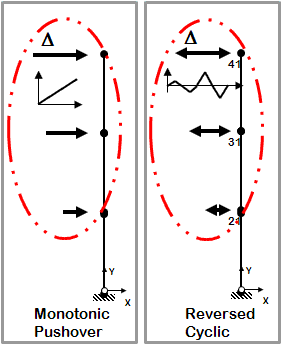
Static Pushover
- Control node is located at the highest floor
- Lateral-load distribution is proportional the the mass distribution along the height of the building
- Static analysis
- Two types
Monotonic Pushover
- One-directional displacement-controlled static lateral loading
Reversed Cyclic Pushover
- One-directional displacement-controlled static lateral loading
- Displacement cycles are imposed in positive and negative direction
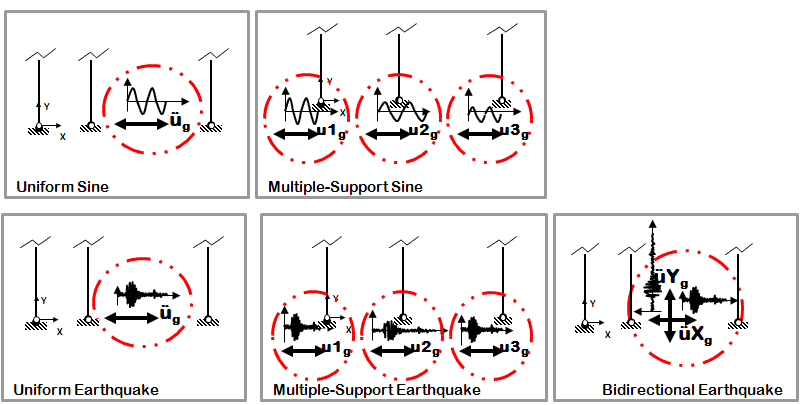
Time-Dependent Dynamic Loads
- Transient analysis
- Four types
Uniform Sine-Wave
- Sine-wave acceleration input
- Same acceleration input at all nodes restrained in specified direction
Multiple-Support Sine-Wave
- Sine-wave displacement input
- Different displacements are specified at particular nodes in specified directions
Uniform Earthquake
- Earthquake (from file) acceleration input
- Same acceleration input at all nodes restrained in specified direction
Multiple-Support Earthquake
- Earthquake (from file) displacement input
- Different displacements are specified at particular nodes in specified direction
Bidirectional Earthquake
- Different inputs are specified for two directions
- Same acceleration input at all nodes restrained in specified direction
Simulation Process
Each example script does the following:
Build the model
- model dimensions and degrees-of-freedom
- nodal coordinates
- nodal constraints -- boundary conditions
- nodal masses
- elements and element connectivity
- recorders for output
Define & apply gravity load
- nodal or element load
- static-analysis parameters (tolerances & load increments)
- analyze
- hold gravity loads constant
- reset time to zero
Define and apply lateral load
- load pattern (nodal loads for static analysis, support ground motion for earthquake)
- lateral-analysis parameters (tolerances & displacement/time increments)
- Static Lateral-Load Analysis
- define the displacement increments and displacement path
- Dynamic Lateral-Load Analysis
- define the input motion and all associated parameters, such as scaling and input type
- define analysis duration and time increment
- define damping
- Static Lateral-Load Analysis
- analyze
Introductory Examples
The objective of Example 1a and Example 1b is to give an overview of input-file format in OpenSees using simple scripts.
These scripts do not take advantage of the Tcl scripting capabilities shown in the later examples. However, they do provide starting a place where the input file is similar to that of more familiar Finite-Element Analysis software. Subsequent examples should be used as the basis for user input files.
|
|
|
|
|
|
|
|
|
|
Simple Examples of Nonlinear-Models
|
|
|
|
|
|
|
|
|
|
|
|
|
|
|
2D Structural Modeling & Analysis Examples
These examples take advantage of the Tcl scripting language starting from simple variable substitutions in the initial examples, to the more advanced techniques of array management and logical expressions (if-then statements).
|
|
|
|
|
|
|
|
|
|
|
|
|
|
|
|
|
|
|
|
3D Structural Modeling & Analysis Examples
A few items are new in 3D:
- Additional coordinates need to be considered in defining nodes
- Additional degrees of freedom need to be considered in defining the following:
- nodal constraints (boundary conditions)
- nodal masses
- nodal loads
- The transformation from local element/section coordinates to global system coordinates needs to be specified
- Element loads are specified in local coordinates
- Additional arguments are required for many elements (bending about local-y axis) properties
- Element/Section torsional stiffness needs to be considered
- Rigid floor diaphragms need be included for building models
|
|
|
|
|
|
|
|
|
|
Section Modeling And Analysis Examples
|
|
|
|
|
Return to OpenSees User
